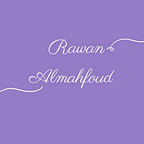case study:Microsite for e-commerce specialized in beach products
Project 2
Introduction
The product was inspired by a Noon customer that was complaining about not finding beach products fast enough and how Noon is an unorganized website. The main aim of this product is to solve this problem that will allow people who love to swim or go to the beach to find a website specialist in beach and swimming stuff. Noon website was our major brand and from this, we created our microsite Amwaj.
Team members:
Atheer Alateeq, Esraa alharbi, Maria Aljaroudi
Project duration:
2 weeks
What is Noon?
Noon is a shopping website and e-commerce company. It was established in 2016 by the famous businessman Mohammed Al-Abbar and funded by the Saudi Public Investment Fund. It attracts more than 15 million visitors per month, and the number is increasing exponentially every month. It works to meet the needs of consumers in all fields, as it offers a variety of different brands in all categories such as electronics, fashion, health products, perfumes, groceries, baby products and household items.
User research
Insight from survey
- 61.5 % order monthly from online shopping websites
- 61.5 % give 6–8 out of 10 as a rate of their trust about online shipping websites.
- 46.6 % choose Apple Pay as their favourite pay method
Interview insight
- Opinions about websites affect their purchase decisions.
- Issues with websites/products trust.
- Need a new method for product search.
- People struggled with Noon as they mentioned it to us.
- Rating products helps them trusting and buy.
- They think sunscreen is essential for the beach.
- We found that the advance of the search engine helps the user and attracts him to continue his shopping.
Affinity Map:
Empathize
- We found that website shopping users suffer from this problem and their inability to find Beach or specific products fast enough.
- Some interviewees mentioned to us Noon as an example of difficulties they’ve faced while searching “sometimes when I search for a specific thing like hats they show me something interiorly different from what I’m searching for and it’s really frustrating and made me angry. Specially Noon. They are really bad when it comes to searching”
Problem statement
Noon customers in Saudi Arabia have the problem that they feel lost while searching for their beach products when they use the website. Our solution should aim to provide more organized and interesting ways to allow our users an easy way to find their products.
Business analysis
C&C analysis
Key insights:
- Asos was our main competition and we want to reach their features level and added more features to create our website.
- Savvi website was a great example of having a chart board, and well-organized products.
- In comparison with the other websites, Savvi was the best in providing a good design app and providing organized products on the website, which facilitated the user experience from reviewed the product to the end of the purchase journey.
- Namshi website provided clear content, good customer service support, and well-organized products.
- For the other websites, they need to label, organize products according to their categories, and avoid stuffed the home page with irrelevant categories of products.
- They also need to focus on providing high-quality photos and put the ads in a separate category.
Landscape/marketing positioning
Organizing The website content is organized and products labelled properly.
Modern The website has the current features of technology and design.
Traditional The website has the traditional features of a website.
Messy The website includes content, design, but the products not well organized.
Key insights:
Websites that their content, products, and design are organized and include present time features of the technology are more likely their users are satisfied with the purchase experience. This allows the user to have a pleasant shopping journey and might visit to purchase again, which means loyal customers in the future.
Leaf diagram
Insight from leaf diagram
- Rating: This feature will make the user trust the product and see other customer’s opinions and rate the product.
- Customer Support: This feature allows the user to receive faster service and feel its value.
- Reverse image search: This feature will allow the user to search for products they need by an image when they forget its name.
- Chat board: This feature will allow the user to chat live with the team if they’re having a question or problem.
User need and business need
Heuristic evaluation
Site map and user flow
Wireframe
After we did the user flow and sitemap we started sketching our website wireframes with my teamwork using Miro and Figma
Annotated wireframes
Prototype
We did a usability test on 5 users. They didn’t like the signup/sign-in page and that’s why we iterated adding sign-in with Facebook or Google. Also, users didn’t like payment options and they were looking for cash on delivery payment.
What could come next?
- We want to expand our products and add new categories of products.
- We want to add AR feature to our website so users can view the product on an existing model before purchasing the product.
In conclusion
- Users want organized and well-labelled products to facilitate their purchases.
- Website design affects user’s judgment about online shopping websites.
- Customer service is what users value the most.
